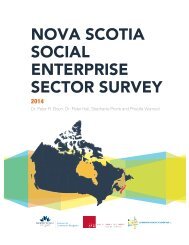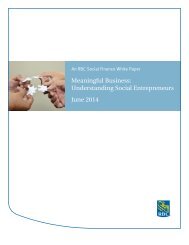Meaningful Business: Understanding Social Entrepreneurs June 2014
Create successful ePaper yourself
Turn your PDF publications into a flip-book with our unique Google optimized e-Paper software.
RBC <strong>Social</strong> Finance<br />
<strong>Meaningful</strong> <strong>Business</strong> 22<br />
Years in <strong>Business</strong><br />
The sample contains businesses at different stages of development. Both social and other businesses are<br />
represented at the different stages.<br />
Less than 5 years<br />
16%<br />
18%<br />
5 to less than 10 years<br />
23%<br />
25%<br />
10 to less than 20 years<br />
30%<br />
30%<br />
20 years or more<br />
27%<br />
32%<br />
0%<br />
5% 10% 15% 20% 25% 30% 35%<br />
Other businesses<br />
<strong>Social</strong> businesses<br />
Data Analysis<br />
The in-depth interviews conducted in the early stages of this study revealed a large number of potential<br />
contributors to entrepreneurial success. These potential contributors were subsequently investigated<br />
within the context of the quantitative survey. The relationship between individual findings and success<br />
(as defined by the success quadrants) are provided within this report. In order to assess contributors of<br />
success from a broader, thematic perspective, a technique called factor analysis was used to group single<br />
contributors into underlying success factors.<br />
Factor analysis is a data reduction technique that allows researchers to group variables that are statistically<br />
related to each other. In doing so, it was possible to examine the relationship between composite scores<br />
of these thematically organized variables and success. Although many hypothesized contributors were<br />
included in the survey; some could not be well explained by the factors that emerged and were not<br />
included in the composite scores. The factors that did emerge included variables that were theme related:<br />
customer leadership, brand leadership, employee focus and results management. Access to capital did<br />
not fit in well mathematically with any of the factors that emerged, but given the importance that it was<br />
given in the qualitative interviews, the relationship between access to capital and success was analyzed<br />
separately. The following table demonstrates the variables included in each of the factors.<br />
< Previous<br />
Back to Contents Next >







